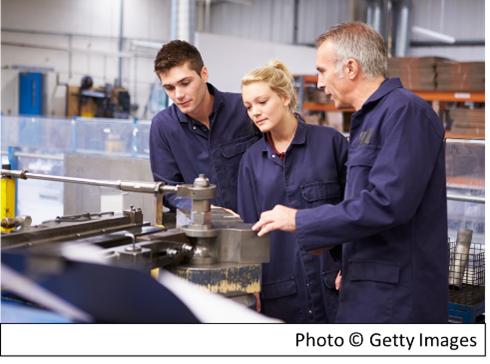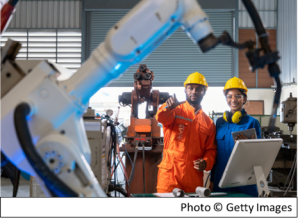Keeping Manufacturing Workers Safe: National Manufacturing Day/Month and Beyond
Posted on byThe blog content expands on information presented in the NIOSH Manufacturing Mondays series.
Manufacturing Day (MFG Day) is celebrated on the first Friday of October and has expanded in some states and organizations to Manufacturing Week or Month. In addition to being an opportunity to showcase modern manufacturing, it’s also an opportunity to inspire the next generation of workers to begin careers in manufacturing. The observance is recognized through a series of focused events throughout the country.
 MFG Day was first held in 2012 as a collaboration between the Fabricators and Manufacturers’ Association and the National Institute for Standards and Technology Manufacturing Extension Partnership as an opportunity to introduce modern manufacturing to new audiences. The National Association of Manufacturers began leading the MFG Day initiative in 2016 and provides resources to assist manufacturing companies in developing, marketing, and hosting MFG Day events. This year, MFG day activities and events are planned in every state and are expected to have record turnout. For the last several years the President has proclaimed the day Manufacturing Day.
MFG Day was first held in 2012 as a collaboration between the Fabricators and Manufacturers’ Association and the National Institute for Standards and Technology Manufacturing Extension Partnership as an opportunity to introduce modern manufacturing to new audiences. The National Association of Manufacturers began leading the MFG Day initiative in 2016 and provides resources to assist manufacturing companies in developing, marketing, and hosting MFG Day events. This year, MFG day activities and events are planned in every state and are expected to have record turnout. For the last several years the President has proclaimed the day Manufacturing Day.
The manufacturing sector represents a large and strategic contribution to America’s economy and employment. According to Bureau of Labor Statistics data, the manufacturing sector represents between 12.8 and 14.5 million employees, depending on how they are reported, with approximately 9 million in production and non-supervisory employment in 2020. The manufacturing sector is diverse. Keeping workers safe is important in manufacturing and all industries and there are many opportunities for safety professionals. The NIOSH Manufacturing Program works with partners in industry, labor, trade associations, professional organizations, and academia. The program focuses on these areas among manufacturing workers:
- Preventing injuries and fatalities from contact with objects and equipment.
- Preventing work-related illnesses such as musculoskeletal disorders and respiratory disease.
- Reducing exposure to occupational safety and health hazards.
- Evaluating new and emerging technologies, both for potential risks to workers and for ways these technologies might protect workers.
Safety and Health in Manufacturing
 There are many occupational safety and health career paths within the manufacturing sector. The primary focus of these occupations is to prevent worker injury and illness. Safety and health jobs can include managers, technicians, trainers and consultants specific to safety, health, or safety and health. Safety is a team effort requiring a diverse and inclusive array of knowledge from the affected personnel. While there are dedicated safety professionals, other manufacturing personnel have duties which directly affect the safety of machines, components, and systems. These different roles are all part of a safety team that is responsible for safety within a process called a safety management system.
There are many occupational safety and health career paths within the manufacturing sector. The primary focus of these occupations is to prevent worker injury and illness. Safety and health jobs can include managers, technicians, trainers and consultants specific to safety, health, or safety and health. Safety is a team effort requiring a diverse and inclusive array of knowledge from the affected personnel. While there are dedicated safety professionals, other manufacturing personnel have duties which directly affect the safety of machines, components, and systems. These different roles are all part of a safety team that is responsible for safety within a process called a safety management system.
The resources in large and small businesses look different. Many small businesses do not have dedicated safety professionals. NIOSH offers resources for small businesses and OSHA operates a small business consultation helpline to assist with compliance.
The OSHA Recommended Practices for Safety and Health Programs is a guide to safety management systems that serves as a good outline of requirements and duties in a safety system whether you are a business owner, a manager, a new safety professional, a manufacturing worker, or a student looking to a future career.
A key duty of safety professionals is the identification and control of hazards. Doing this requires an iterative process of identification and control. First a task-based risk assessment should be done for each task in a process or at a machine. The design of hazard controls should consider the Hierarchy of Controls which, from generally most effective to least effective, are: elimination, substitution, engineering controls, administrative controls, and personal protective equipment. This process is repeated with each control until hazards are reduced to an acceptable level. Hazard controls may create new hazards which need addressed. The decisions and processes created to control safety are reinforced with training. This process of “designing out” or minimizing hazards and risks is one of the best ways to prevent and control occupational injuries, illnesses, and fatalities is often called Prevention through Design.
Information for Safety Professionals
Safety professionals identify hazards as part of a team, design and control processes to ensure safe practices but doing so requires information. The following are valuable resources for safety professionals.
The NIOSH website provides information on the NIOSH manufacturing program and hazards such as machine safety.
NIOSH and OSHA have many resources to help understand the circumstances contributing to workplace injuries and deaths and the related regulations. These are useful to a burgeoning practitioner or a seasoned professional. The NIOSH FACE (Fatality Assessment Control and Evaluation) Program investigates workplace fatalities to find root causes and provide recommendations to prevent future fatalities. OSHA provides investigation material on their site as well as warning citations, and citations with fines for each industry and applicable NAICS code (used for industry classification). The OSHA regulations can be found in Title 29 of the CFR (Code of Federal Regulations).
Voluntary industry standards are an important part of a safety program and an important part of a safety professionals’ career. OSHA considers these industry standards in writing regulations. They are available from ANSI (American National Standards Institute) and other industry and professional organizations. Industry standards can often provide critical guidance on the safe use and configuration of machines, machine integration, and safety best practices. Many of these voluntary standards have incorporated research from NIOSH and other groups.
The resource section below contains links to organizations offering training for safety and health professionals. The NIOSH-funded Education and Research Centers also offer many training opportunities.
A Diverse Inclusive Knowledgeable Safety Team
Safety professionals use these resources and teamwork to prevent injury and illness. Whether you plan to have a career in safety or elsewhere in manufacturing know that there are many people working to make manufacturing a safer industry to work in. Also realize, that wherever you work in manufacturing, you are part of a diverse inclusive safety team, and your knowledge of that process makes it safer for you and everyone around you.
Richard Current, PE, NIOSH Manufacturing Sector Program Assistant Coordinator.
Adam Smith, PhD, NIOSH Manufacturing Sector Program Assistant Coordinator.
Jenny Topmiller, MS, NIOSH Manufacturing Sector Program Co-Coordinator.
RJ Matetic, MS, PhD, NIOSH Associate Director for Manufacturing.
The Manufacturing Program highlights activities within the program and throughout the world of Manufacturing. To share your ideas for future topics contact us at mnf-program@cdc.gov.
For More Information
Manufacturing Day (mfgday.com)
Manufacturing Day – Its Genesis and Evolution | NIST
Training and Occupational Safety Information
Public Health in STEM Education (cdc.gov)
Training | Occupational Safety and Health Administration (osha.gov)
Workplace Safety and Health Topics | NIOSH | CDC
Fatality Assessment and Control Evaluation (FACE) Program | NIOSH | CDC
Industries at a Glance: Manufacturing: NAICS 31-33 (bls.gov)
ASSP – American Society of Safety Professionals | ASSP
Free Educational Resources for Safety Professionals | ASSP
American National Standards Institute – ANSI Home
American Welding Society (aws.org)
National Association of Manufacturers | NAM
Prevention through Design
Prevention through Design | NIOSH | CDC
Posted on by

